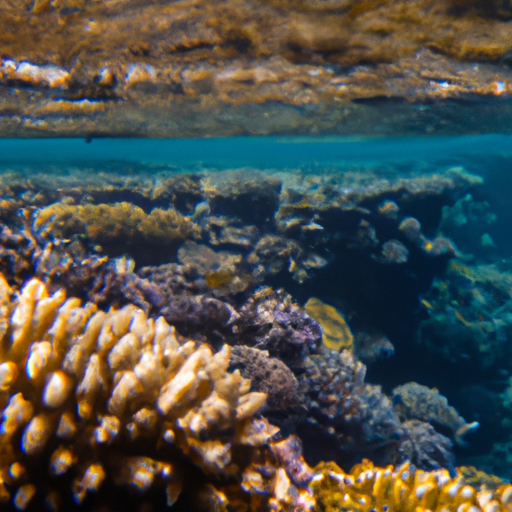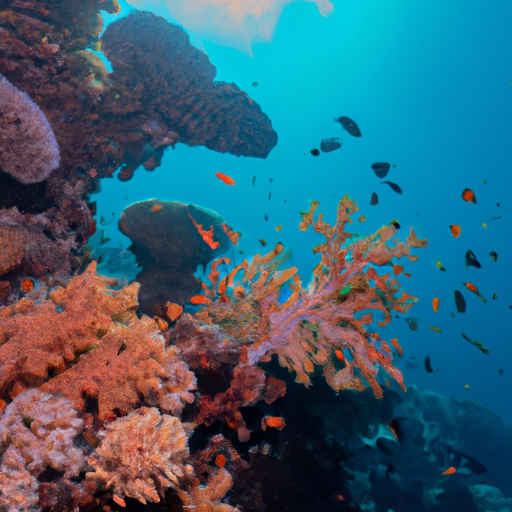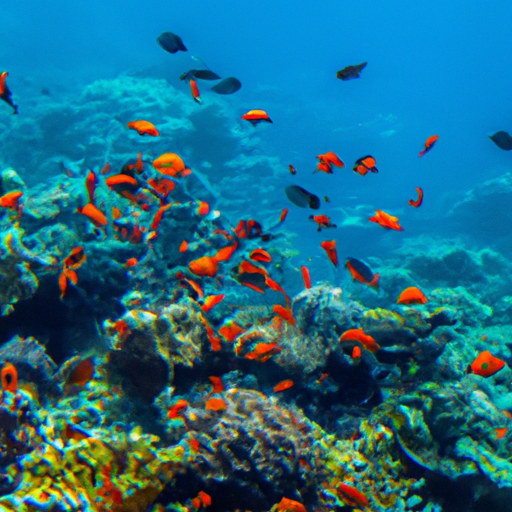
The Impact of Climate Change on Marine Life: An Overview
Marine life plays a crucial role in maintaining the health and balance of ocean ecosystems, which in turn has a significant impact on the overall health of our planet. However, the increasing effects of climate change are posing a serious threat to marine life and the delicate balance of these ecosystems.
Understanding the impact of climate change on ocean ecosystems is essential to develop effective conservation and management strategies to mitigate its negative consequences. Rising sea temperatures are one of the most significant factors affecting marine life. As the oceans absorb more heat from the atmosphere, it disrupts the natural temperature ranges that marine organisms have adapted to over millions of years.
These temperature shifts can disrupt the reproductive cycles of fish, turtles, and other marine animals, leading to a decline in their populations. For example, rising temperatures can cause coral bleaching, a phenomenon where corals expel the algae living in their tissues, resulting in their death. Coral reefs support a diverse range of marine species, and their decline could have devastating consequences for the entire ecosystem.
Another consequence of climate change on marine life is ocean acidification. As carbon dioxide levels rise in the atmosphere, a portion of it is absorbed by the oceans, leading to increased acidity. This change in pH can have severe impacts on marine organisms, particularly those with calcium carbonate shells or skeletons, such as shellfish, corals, and some planktonic species.
Acidic waters can hinder the growth and development of these organisms, making it difficult for them to form and maintain their protective structures. This not only affects their survival, but it also has far-reaching implications for the entire food web, as many other organisms depend on these species for food and shelter.
Another critical aspect of climate change’s impact on marine life is the disruption of ocean currents and weather patterns. As global temperatures rise, the melting of polar ice caps and glaciers results in the influx of freshwater into the oceans. This influx alters the salinity levels and can disrupt the nutrient distribution within the oceans.
Marine organisms that rely on specific nutrient compositions and current patterns for their survival and reproduction may struggle to adapt to these changes. For migratory species such as sea turtles and certain fish, alterations in ocean currents can impact their ability to find food or reach their breeding grounds.
In conclusion, climate change is significantly impacting marine life and the delicate balance of ocean ecosystems. The rising temperatures, ocean acidification, and changes in current patterns pose significant challenges to the survival and wellbeing of marine organisms. It is crucial to continue studying and understanding these impacts to develop the necessary strategies to mitigate the effects of climate change on marine life and preserve the health of our oceans.
Rising Sea Temperatures and their Effects on Ocean Ecosystems
Marine life is intricately connected to the health and stability of ocean ecosystems. However, rising sea temperatures caused by climate change are posing significant challenges to the survival and functioning of these ecosystems. Understanding the impact of climate change on marine life is crucial for implementing effective conservation strategies and ensuring the long-term sustainability of our oceans.
One of the most noticeable effects of rising sea temperatures is the disruption of marine food webs. Many species of plankton, which form the foundation of these webs, are extremely sensitive to changes in water temperature. As the temperature rises, certain species of plankton decline, while others thrive. This leads to imbalances in the availability of food for higher-level organisms such as fish and marine mammals. Additionally, the loss of certain plankton species can have cascading effects on the entire ecosystem, as these tiny organisms play a vital role in carbon sequestration and oxygen production.
Climate change also affects the distribution and behavior of marine species. As waters warm, some species may be forced to migrate to find suitable habitats with optimal temperature conditions. This can lead to shifts in species composition and alterations in predator-prey dynamics. For example, certain fish species may move to higher latitudes in search of cooler waters, impacting the availability of prey for marine mammals and seabirds in their original habitats. These shifts can disrupt complex ecological interactions and potentially lead to population declines or even extinctions.
The increased temperature of ocean waters also poses a direct threat to marine organisms, particularly those that are adapted to specific temperature ranges. For example, coral reefs are highly vulnerable to bleaching events, which occur when corals expel the symbiotic algae that provide them with nutrients and give them their vibrant colors. Bleaching is often triggered by high water temperatures, and if the stress continues for an extended period, corals can die. This not only impacts the beauty and biodiversity of coral reefs but also the multitude of species that rely on them for shelter, food, and breeding grounds.
Furthermore, rising sea temperatures can promote the spread of diseases among marine organisms. Warmer waters provide an ideal environment for the growth and proliferation of pathogens, leading to increased disease outbreaks in various species. This can further weaken already stressed populations and contribute to declines in overall biodiversity.
In conclusion, rising sea temperatures as a result of climate change have far-reaching consequences for ocean ecosystems and the marine life they support. Understanding and mitigating these impacts is essential for preserving the intricate balance and biodiversity of our oceans. Implementing sustainable practices and reducing greenhouse gas emissions are crucial steps in protecting marine ecosystems and ensuring the survival of our precious marine life.
Ocean Acidification: A Threat to Marine Life and Coral Reefs
Marine life is integral to the health and balance of our planet’s ecosystems. From tiny plankton to majestic whales, each species plays a unique and important role in the complex web of life beneath the ocean’s surface. However, these delicate ecosystems are facing an unprecedented threat – climate change.
Climate change, caused primarily by the burning of fossil fuels and the release of greenhouse gases into the atmosphere, is disrupting the natural balance of our planet. Rising temperatures, melting ice caps, and extreme weather events are just some of the most visible effects of this global phenomenon. However, one lesser-known consequence of climate change is ocean acidification, which poses a significant threat to marine life and coral reefs.
Ocean acidification occurs when the excess carbon dioxide (CO2) in the atmosphere is absorbed by seawater. This process leads to a decrease in the pH levels of the ocean, making it more acidic. Since the beginning of the Industrial Revolution, the ocean’s acidity has increased by about 30%, faster than any other time in the past 50 million years. This rapid change in pH levels has profound effects on marine life and the delicate balance of ocean ecosystems.
Coral reefs, often referred to as the rainforests of the sea, are particularly vulnerable to the effects of ocean acidification. Corals rely on a delicate balance of calcium carbonate to build their exoskeletons. However, increased acidity inhibits their ability to form these structures, causing coral bleaching and the eventual death of entire reef systems. Without healthy coral reefs, countless species of fish, invertebrates, and other marine creatures lose their habitat and food sources.
Furthermore, ocean acidification affects various other marine organisms, including shellfish, mollusks, and microscopic organisms like phytoplankton. These species are crucial not only for the ocean’s biodiversity but also for the larger food chain. As their populations decline, it creates a ripple effect that impacts other fish, marine mammals, and even humans who rely on seafood as a primary food source.
Understanding the impact of climate change and ocean acidification on marine life is crucial for developing effective conservation strategies. Efforts to reduce greenhouse gas emissions, promote sustainable fishing practices, and protect marine habitats are essential in mitigating the damaging effects of climate change on our oceans. As individuals, we can also make a difference by being mindful of our carbon footprint and supporting organizations that work towards preserving our precious marine ecosystems.
By recognizing the importance of marine life and its vulnerability to climate change, we can take collective action to protect our oceans and ensure their health for future generations.
Rising Sea Levels: How Climate Change is Transforming Coastal Habitats
Marine life is profoundly affected by climate change and rising sea levels. As the Earth’s temperature continues to rise, the oceans are also warming up, causing significant changes to ocean ecosystems. These changes have a direct impact on marine species and the delicate balance of marine life.
One of the primary effects of climate change on marine life is the loss of habitat. As sea levels rise, coastal habitats such as mangroves, coral reefs, and salt marshes are threatened. These habitats are essential for many marine species as they provide food, shelter, and breeding grounds. The loss of these habitats can lead to a decline in fish populations and disrupt the entire food chain.
In addition to habitat loss, climate change also leads to ocean acidification. Increased levels of carbon dioxide in the atmosphere are absorbed by the ocean, causing the water to become more acidic. This change in pH has severe consequences for marine life, especially for organisms such as coral reefs, shellfish, and other calcifying species. Acidic waters make it difficult for these organisms to build and maintain their shells and skeletons, ultimately leading to their decline.
Rising sea temperatures due to global warming also pose a significant threat to marine life. Many species, including corals and fish, have specific temperature tolerances. As the water gets warmer, these species may be forced to move to cooler areas or face the risk of extinction. The relocation of marine species can disrupt established ecosystems and lead to competition for resources.
Climate change and rising sea levels also have indirect impacts on marine life through changes in ocean currents and weather patterns. These changes affect the distribution and availability of food sources for marine species. For example, alterations in ocean currents can disrupt the migration patterns of fish, leading to a decline in their population. Unpredictable weather patterns can also impact the reproductive cycles of marine organisms, affecting their ability to reproduce and replenish their populations.
To understand and mitigate the impact of climate change on marine life, it is crucial to continue researching and monitoring ocean ecosystems. Conservation efforts focused on protecting and restoring coastal habitats are essential for maintaining healthy marine environments. Additionally, reducing carbon emissions and implementing sustainable practices can help slow down the warming of the oceans and limit the damage to marine ecosystems.
In conclusion, climate change and rising sea levels have far-reaching consequences for marine life. The loss of habitat, ocean acidification, and rising temperatures all pose significant threats to the delicate balance of ocean ecosystems. Understanding and addressing these challenges are vital for the long-term survival of marine species and the health of our oceans.


